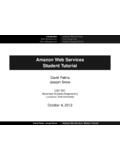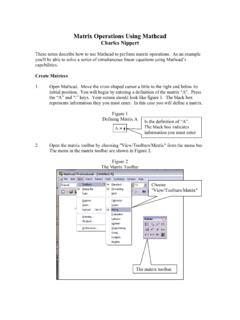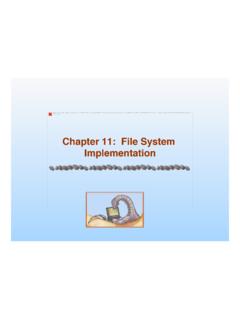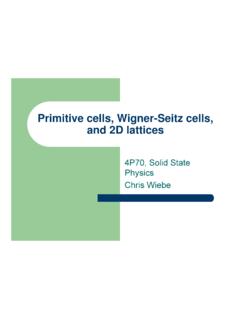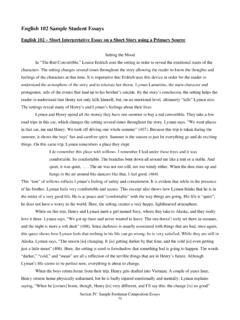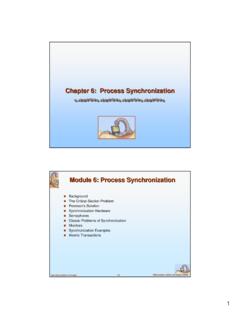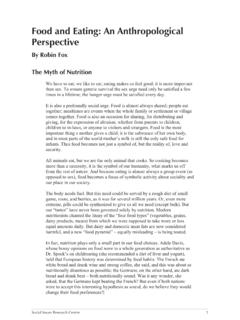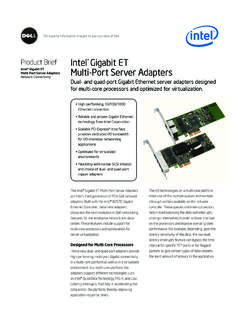Transcription of Chapter 5: CPU Scheduling - Welcome to Watson
1 Silberschatz, Galvin and Gagne 2002 !Operating System Concepts! Chapter 5: CPU Scheduling ! Basic Concepts! Scheduling Criteria ! Scheduling Algorithms! Multiple-Processor Scheduling ! Real-Time Scheduling ! Algorithm Evaluation!Silberschatz, Galvin and Gagne 2002 !Basic Concepts! Long-term scheduler is invoked very infrequently (seconds, minutes) (may be slow)! The long-term scheduler controls the degree of multiprogramming (how many jobs are admitted to run on CPU)! Short-term scheduler is invoked very frequently (milliseconds) (must be fast) = process Scheduling on CPU ! Processes can be described as either:! I/O-bound process spends more time doing I/O than computations, many short CPU bursts! CPU-bound process spends more time doing computations; few very long CPU bursts!Silberschatz, Galvin and Gagne 2002 !Operating System Concepts!Basic Concepts! Maximum CPU utilization obtained with multiprogramming!
2 CPU I/O Burst Cycle Process execution consists of a cycle of CPU execution and I/O wait.! CPU burst distribution!Silberschatz, Galvin and Gagne 2002 !Operating System Concepts!Alternating Sequence of CPU And I/O Bursts!Silberschatz, Galvin and Gagne 2002 !Operating System Concepts!Histogram of CPU-burst Times! !Silberschatz, Galvin and Gagne 2005!Operating System Concepts!Diagram of Process State!CPU Scheduling is a mechanism to migrate processes to various states from/to various queues! !Silberschatz, Galvin and Gagne 2005!Operating System Concepts!Operating System Concepts!CPU Scheduler! Selects from among the processes in memory ( Ready Queue) that are ready to execute, and allocates the CPU to one of them.!1. Preemptive: allows a process to be interrupted in the midst of its CPU execution, taking the CPU away to another process!2. Non- Preemptive: ensures that a process relinquishes control of CPU when it finishes with its current CPU burst!
3 Silberschatz, Galvin and Gagne 2002 !Operating System Concepts!CPU Scheduler! CPU Scheduling decisions may take place when a process:!1.!Switches from running to waiting state.!2.!Switches from running to ready state.!3.!Switches from waiting to ready.!4.!Terminates.! Preemptive: allows a process to be interrupted! Non- Preemptive: allows a process finishes with its current CPU burst! Scheduling under 1 and 4 is nonpreemptive.! All other Scheduling is preemptive.!Silberschatz, Galvin and Gagne 2002 !Context Switching!Silberschatz, Galvin and Gagne 2002 !Operating System Concepts!Dispatcher! Dispatcher module gives control of the CPU to the process selected by the short-term scheduler; this involves:! switching context! switching to user mode! jumping to the proper location in the user program to restart that program! Dispatch latency time it takes for the dispatcher to stop one process and start another running.
4 !Silberschatz, Galvin and Gagne 2002 !Operating System Concepts!What hardware components impact the Dispatcher latency?!Silberschatz, Galvin and Gagne 2002 !Operating System Concepts! Scheduling Criteria! CPU utilization keep the CPU as busy as possible! Throughput # of processes that complete their execution per time unit! Turnaround time amount of time to execute a particular process (finishing time arrival time)! Waiting time amount of time a process has been waiting in the ready queue! Response time amount of time it takes from when a request was submitted until the first response is produced, not output (for time-sharing environment)!Silberschatz, Galvin and Gagne 2002 !Operating System Concepts!Optimization Criteria! Max CPU utilization! Max throughput! Min turnaround time ! Min waiting time ! Min response time!Silberschatz, Galvin and Gagne 2002 !Operating System Concepts!
5 First-Come, First-Served (FCFS) Scheduling !!!Process!Burst Time!!!!P1!24!!! P2 !3!!! P3! 3 ! Suppose that the processes arrive in the order: P1 , P2 , P3 The Gantt Chart for the schedule is: ! Waiting time for P1 = 0; P2 = 24; P3 = 27! Average waiting time: (0 + 24 + 27)/3 = 17!P1!P2!P3!24!27!30!0!Silberschatz, Galvin and Gagne 2002 !Operating System Concepts!FCFS Scheduling (Cont.)!Suppose that the processes arrive in the order!!! P2 , P3 , P1 .! The Gantt chart for the schedule is: ! Waiting time for P1 = 6; P2 = 0; P3 = 3! Average waiting time: (6 + 0 + 3)/3 = 3! Much better than previous case.! Convoy effect short process behind long process!P1!P3!P2!6!3!30!0!Silberschatz, Galvin and Gagne 2002 !Operating System Concepts!Shortest-Job-First (SJR) Scheduling ! Associate with each process the length of its next CPU burst. Use these lengths to schedule the process with the shortest time.
6 ! Two schemes: ! nonpreemptive once CPU given to the process it cannot be preempted until completes its CPU burst.! preemptive if a new process arrives with CPU burst length less than remaining time of current executing process, preempt. This scheme is know as the Shortest-Remaining-Time-First (SRTF).! SJF is optimal gives minimum average waiting time for a given set of processes.!Silberschatz, Galvin and Gagne 2002 !Operating System Concepts!!!Process!Arrival Time!Burst Time!!!P1! !7!!! P2! !4!!! P3! !1!!! P4! !4! SJF (non-preemptive)! Average waiting time = (0 + 6 + 3 + 7)/4 - 4!Example of Non-Preemptive SJF!P1!P3!P2!7!3!16!0!P4!8!12!Silberscha tz, Galvin and Gagne 2002 !Operating System Concepts!Example of Preemptive SJF!!!Process!Arrival Time!Burst Time!!!P1! !7!!! P2! !4!!! P3! !1!!! P4! !4! SJF (preemptive)! Average waiting time = (9 + 1 + 0 +2)/4 = 3!P1!P3!P2!4!2!11!0!P4!
7 5!7!P2!P1!16!Silberschatz, Galvin and Gagne 2002 !Operating System Concepts!!!Process!Arrival Time!Burst Time!!!P1! !7!!! P2! !4!!! P3! !1!!! P4! !4!1. FCFS & no preemption vs. SJF vs Preemptive SJF ! Wait time is an overall time that a process waits after the arrival! Compare Average waiting time of all algorithms!In class exercise!Silberschatz, Galvin and Gagne 2002 !Operating System Concepts!Determining Length of Next CPU Burst! Can only estimate the length.! Can be done by using the length of previous CPU bursts, using exponential averaging.!!!1. tn=actual lenght of nthCPU burst2. n+1= predicted value for the next CPU burst3. , 0 14. Define: n+1= tn+1 () , Galvin and Gagne 2002 !Operating System Concepts!Prediction of the Length of the Next CPU Burst!Silberschatz, Galvin and Gagne 2002 !Operating System Concepts!Examples of Exponential Averaging! =0! n+1 = n! Recent history does not count.
8 ! =1! n+1 = tn! Only the actual last CPU burst counts.! If we expand the formula, we get:! n+1 = tn+(1 - ) tn -1 + ..! +(1 - )j tn -1 + ..! +(1 - )n=1 tn 0! Since both and (1 - ) are less than or equal to 1, each successive term has less weight than its predecessor.!Silberschatz, Galvin and Gagne 2002 !Important Announcements ! Mid Term Exam: April 10, 2014 ! Assignment hand in policy! Submit your hardcopy in class! Send my grader an electronic version & CC me Programming assignment 1: Apr 22! Term Paper: Apr 24!Operating System Concepts!Silberschatz, Galvin and Gagne 2002 !Operating System Concepts!Priority Scheduling ! A priority number (integer) is associated with each process! The CPU is allocated to the process with the highest priority (smallest integer highest priority).! Preemptive! nonpreemptive! SJF is a priority Scheduling where priority is the predicted next CPU burst time.
9 ! Problem Starvation low priority processes may never execute.! Solution Aging as time progresses increase the priority of the process.!Silberschatz, Galvin and Gagne 2002 !Operating System Concepts!Round Robin (RR)! Each process gets a small unit of CPU time (time quantum), usually 10-100 milliseconds. After this time has elapsed, the process is preempted and added to the end of the ready queue.! If there are n processes in the ready queue and the time quantum is q, then each process gets 1/n of the CPU time in chunks of at most q time units at once. No process waits more than (n-1)q time units.! Performance! q large FIFO! q small q must be large with respect to context switch, otherwise overhead is too high.!Silberschatz, Galvin and Gagne 2002 !Operating System Concepts!Example of RR with Time Quantum = 20!!!Process!Burst Time!!!P1!53!!! P2! 17!!! P3!68!!! P4! 24! The Gantt chart is: !
10 Typically, higher average turnaround than SJF, but better response.!P1!P2!P3!P4!P1!P3!P4!P1!P3!P3! 0!20!37!57!77!97!117!121!134!154!162!Sil berschatz, Galvin and Gagne 2002 !Operating System Concepts!Time Quantum and Context Switch Time!Silberschatz, Galvin and Gagne 2002 !Operating System Concepts! Scheduling Criteria! CPU utilization keep the CPU as busy as possible! Throughput # of processes that complete their execution per time unit! Turnaround time amount of time to execute a particular process (finishing time arrival time)! Waiting time amount of time a process has been waiting in the ready queue after arrival! Response time amount of time it takes from when a request was submitted until the first response is produced, not output (for time-sharing environment)!Silberschatz, Galvin and Gagne 2002 !Operating System Concepts!Class Exercise!Process!Time!p1!6!P2!3!P3!7!p4!
